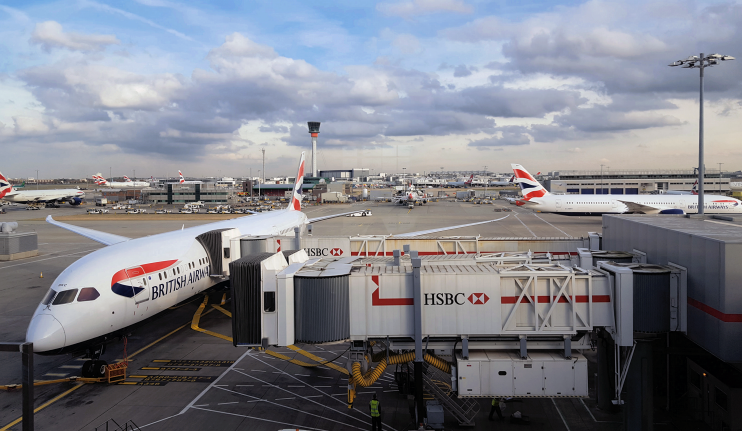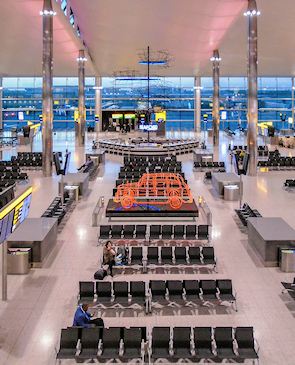Heathrow
Heathrow, Hillingdon
Europe’s busiest airport, situated on the western edge of Greater London

Although Heathrow made a relatively late appearance as a hamlet on the edge of Hounslow Heath – its presence was not recorded until 1453 – this area was rich in archaeological treasures, with evidence of Bronze Age farming and the only Iron Age temple colonnade in England.
Aviation began here in 1930 and the government requisitioned the site as a bomber airfield shortly before the end of the Second World War. This seems to have been a ploy to sidestep public objections to Heathrow’s intended commercial use when the war was over.
Construction of the airport obliterated the village of Heathrow and the neighbouring hamlet of Perry Oaks, together with the prehistoric sites. An 18th-century farmhouse called Heathrow Hall was pulled down in 1944. The older and prettier Perry Oaks farmhouse was demolished in 1948.
The first departure from London Airport (as it was originally known) was a British South American Airways proving flight to Buenos Aires, on 1 January 1946. The airport was fully opened for civil aviation on 31 May 1946.
Construction of the terminal buildings at the centre of the airport site began in 1955 and finished in 1968, when a 160-acre (65-hectare) cargo site was added to the south, with a linking tunnel. The cargo area has often been the target of thieves and London’s biggest ever robbery took place here in 1983, when £26 million worth of gold bullion and diamonds were stolen from the Brinks-Mat high security vault. Most of the gold was never recovered.
On the airport’s southern perimeter, Terminal 4 was completed in 1986.
At the western edge, Terminal 5 was planned from the late 1980s and more than 80,000 artefacts were uncovered during archaeological excavations prior to the commencement of construction in 2002. When the terminal opened in March 2008 system faults and problems with ‘staff familiarisation’ caused baggage delays, temporary suspensions of check-in facilities and the cancellation of more than 500 flights over a ten-day period. A House of Commons Transport Committee report later called this a ‘national embarrassment’. For the most part, T5 has since functioned smoothly.

Terminal 1 closed in 2015, following the reconstruction and enlargement of Terminal 2.
Heathrow airport presently covers 4¾ square miles (12.3 square kilometres). It handles more than 75 million passengers and 1.5 million tonnes of freight every year. Within the airport perimeter 76,500 people are employed and many firms in the surrounding localities depend on the airport for their existence.
The Piccadilly line was extended to Heathrow in 1977 and there are now separate stations for terminals 2 & 3, 4 and 5. The Heathrow Express opened in 1998 and links the airport to Paddington. The former Heathrow Connect service has been absorbed into the Elizabeth line (Crossrail).
Heathrow Airport’s central bus and coach station is the busiest such hub in the UK.
Based on Newall Road, in what was the airport’s visitor centre, the Heathrow Academy is a staff recruitment and training facility.
Controversial plans to build a third runway and a sixth terminal have been the subject of consultation, resistance and revision for nearly two decades. The Labour government originally authorised the runway’s construction in 2009. A year later the incoming coalition government cancelled the project and subsequently played for time by setting up the Airports Commission, which was tasked with recommending the best way to expand aviation capacity in the UK. In July 2015 the commission unanimously concluded that the (revised) proposal for a new north-west runway at Heathrow “presents the strongest case and offers the greatest strategic and economic benefits.” The Conservative government reluctantly endorsed this recommendation in October 2016.
More stages of consultation are still required – which will doubtless continue to be accompanied by vigorous opposition, not least because the scheme would eradicate the entire village of Longford, together with half of Harmondsworth and a sliver of Sipson. Terminal 6 is presently proposed for location next door to Terminal 5. Construction work cannot begin until after a development consent order is granted, which will not be for several more years – and the expansion looks increasingly unlikely to happen at all.
Postcode area: Hounslow TW6
Population: 13,580 (Heathrow Villages, mid-2014 estimate; ward includes Harlington, Harmondsworth, Longford and Sipson)
Stations: Terminals 2 & 3 (aka Heathrow Central), Terminal 4, Terminal 5 (served by the Heathrow Express and the Piccadilly and Elizabeth lines, zone 6)
Further reading: Kevan James, Heathrow Airport: An Illustrated History, Fonthill, 2016
and Adrian M Balch, Heathrow in Photographs: Celebrating 70 Years of London’s Airport, History Press, 2016
Websites: Heathrow Airport, Heathrow Airport Guide, Heathrow Association for the Control of Aircraft Noise
